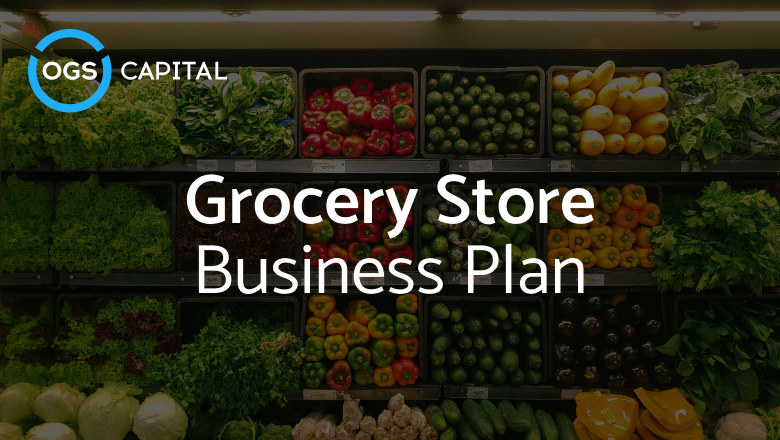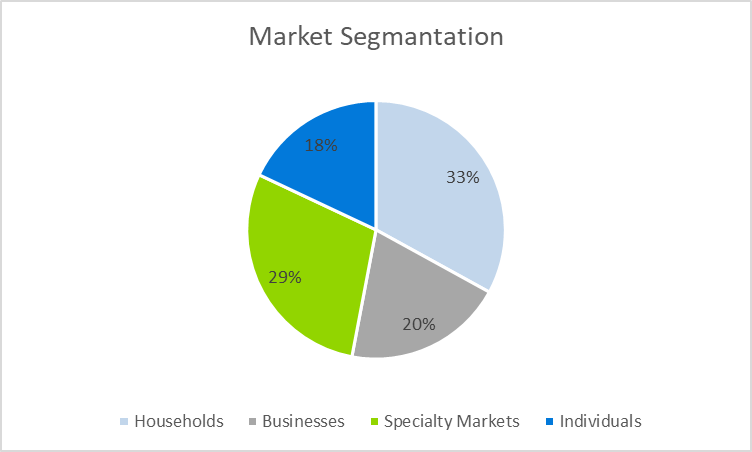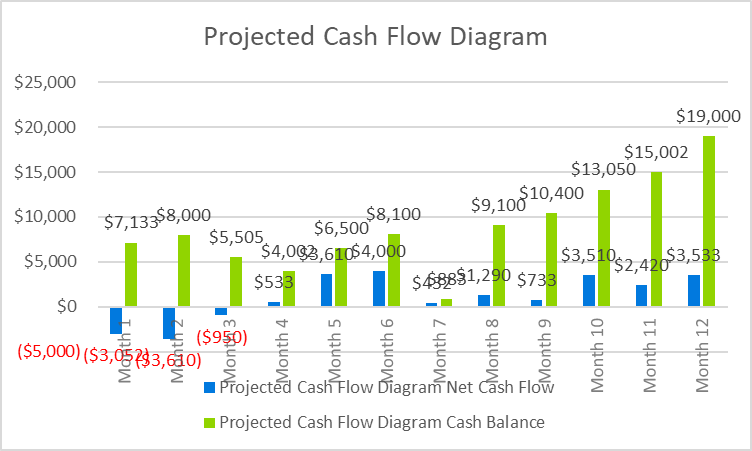Table of Content
1. Business Plan For Opening A Grocery Store
Opening a grocery store can help meet the needs of a local community by providing a convenient source of fresh food and other staples. This can help improve the health and well-being of the community by providing access to affordable nutritious food.
With the right business plan, a grocery store can also provide employment opportunities to local residents, allowing them to gain valuable skills and experience while helping to build the local economy.
The Butcher Shop Business Plan can also serve as a community hub, providing a safe and welcoming place for people to gather and interact. A grocery store can become a valuable asset for the local community by providing these services and conveniences.
2. Executive Summary for Business Plan for Grocery Store
The Business
ABC Grocery Store will be a full-service grocery store offering various products, including organic and locally-sourced products. The store will be in a busy commercial area, featuring a modern, clean, and inviting atmosphere. In the Gourmet Food Store Business Plan, the store will have a self-checkout system and will offer online ordering and delivery services. The store will also offer various locally-sourced products, including fruits and vegetables, meats, cheese, bread, and other items.
ABC Grocery Store will exceed customer expectations for quality and convenience and provide a unique shopping experience that is focused on customer service, quality, and value.
Business Target
ABC Grocery Store will target the local residents of the area, as well as customers from the surrounding areas. The store will focus on providing high-quality products, excellent customer service, and competitive prices. In the Donut Shop Business Plan, the store will also focus on providing a unique and enjoyable shopping experience and will strive to create a welcoming and inviting atmosphere. The store will be open seven days a week, from 8 am to 9 pm, and will offer a wide range of products that will cater to the needs of all types of customers.
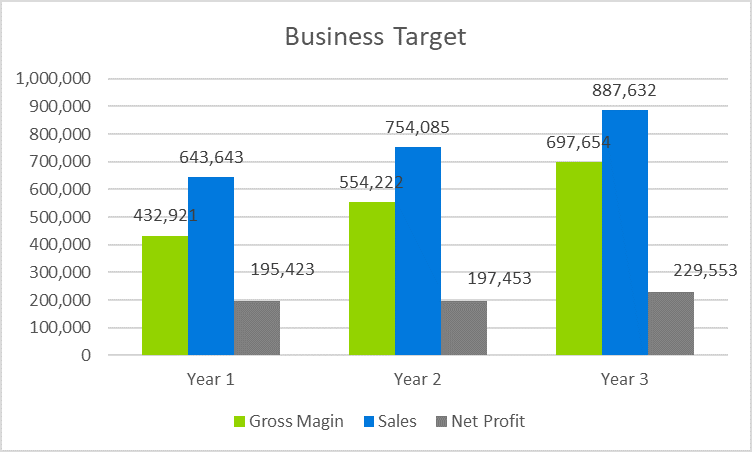
3. Company Summary
ABC Grocery Store is a new grocery store in the heart of downtown San Francisco. In the small grocery store business plan, we will offer a wide selection of fresh produce, dairy products, meat, canned goods, frozen foods, and a full selection of grocery items.
Company Owner
ABC Grocery Store is owned by Sany, a long-time resident of the area. Sany has extensive grocery business experience and a passion for providing quality products to his customers. Sany is firmly committed to the local community and is dedicated to making ABC Grocery Store a success.
Why The Grocery Store Business Is Being Started
The grocery store business is being started because there is a need for a grocery store in the downtown San Francisco area. The current mobile grocery stores in the area are not meeting the needs of the local population. We plan to fill this void by offering high-quality products at competitive prices.
How The Grocery Store Business Will Be Started
ABC Grocery Store will begin by securing a location in the local community. We will then purchase the necessary equipment and supplies to stock the store. We will also hire staff to help manage the store and to provide customer service.
Note
We will market our business through local advertising and social media in the grocery store business plan sample. Finally, we will create a website that will provide customers with a convenient way to shop from the comfort of their own homes.
The experts estimate the grocery store business plan’s assets, investments, and costs.
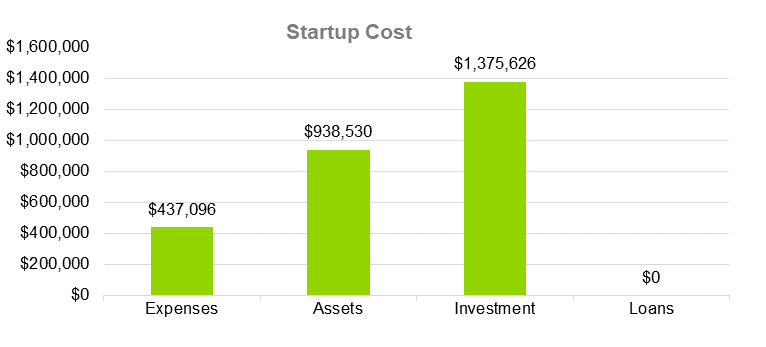
In order to start a Coffee Shop Business Plan, you must meet the following criteria: total startup expenses, total assets, total startup funding, total funding required, total assets, total liabilities, total planned investments, total capital, total liabilities, and total funding.
| Start-up Expenses | |
| Legal | $178,765 |
| Consultants | $0 |
| Insurance | $18,987 |
| Rent | $32,976 |
| Research and Development | $10,000 |
| Expensed Equipment | $193,368 |
| Signs | $3,000 |
| TOTAL START-UP EXPENSES | $437,096 |
| Start-up Assets | $240,000 |
| Cash Required | $119,750 |
| Start-up Inventory | $101,860 |
| Other Current Assets | $221,320 |
| Long-term Assets | $255,600 |
| TOTAL ASSETS | $938,530 |
| Total Requirements | $1,375,626 |
| START-UP FUNDING | |
| Start-up Expenses to Fund | $437,096 |
| Start-up Assets to Fund | $938,530 |
| TOTAL FUNDING REQUIRED | $1,375,626 |
| Assets | |
| Non-cash Assets from Start-up | $1,280,390 |
| Cash Requirements from Start-up | $196,550 |
| Additional Cash Raised | $48,050 |
| Cash Balance on Starting Date | $36,000 |
| TOTAL ASSETS | $1,560,990 |
| Liabilities and Capital | |
| Liabilities | $18,500 |
| Current Borrowing | $0 |
| Long-term Liabilities | $0 |
| Accounts Payable (Outstanding Bills) | $15,265 |
| Other Current Liabilities (interest-free) | $0 |
| TOTAL LIABILITIES | $33,765 |
| Capital | |
| Planned Investment | $1,375,626 |
| Investor 1 | $0 |
| Investor 2 | $0 |
| Other | $0 |
| Additional Investment Requirement | $0 |
| TOTAL PLANNED INVESTMENT | $1,375,626 |
| Loss at Start-up (Start-up Expenses) | $151,599 |
| TOTAL CAPITAL | $1,527,225 |
| TOTAL CAPITAL AND LIABILITIES | $1,560,990 |
| Total Funding | $1,375,626 |
4. Products
This mini grocery store business plan outlines the launch and operation of ABC Grocery Store, a full-service retail grocery store in San Francisco area. ABC Grocery Store will provide customers with fresh, high-quality, organic, locally-sourced food products, household goods, and health and beauty products.
- Meat/Seafood: Beef, Chicken, Pork, Fish, Shrimp
- Dairy: Milk, Cheese, Butter, Yogurt, Eggs
- Frozen Foods: Ice Cream, Pizza, French Fries, Frozen Dinners, Vegetables
- Bakery: Bread, Bagels, Cookies, Cakes, Donuts
- Grocery: Cereal, Pasta, Rice, Canned Goods, Snacks
- Household Items: Paper Towels, Toilet Paper, Soap, Detergent, Cleaning Supplies
- Health and Beauty: Toothpaste, Shampoo, Conditioner, Makeup, Vitamins
- Beverages: Soda, Water, Juice, Coffee, Tea
- Pet Food: Dog Food, Cat Food, Treats, Toys, Supplies
- Organic/Natural Foods: Fruits, Vegetables, Meat, Dairy, Grocery Items
excellent work
excellent work, competent advice. Alex is very friendly, great communication. 100% I recommend CGS capital. Thank you so much for your hard work!
5. Marketing Analysis
The grocery store industry is highly competitive and the success of a grocery store business depends upon its ability to understand the market, develop a competitive advantage and effectively differentiate from its competitors. To gain a competitive advantage, the grocery store must identify its target market, understand the needs of its target market, develop a unique selling proposition, and create a strong marketing strategy.
Market Trends
The growth of the grocery store industry is largely dependent on economic conditions and population growth. The industry is expected to continue to experience steady growth in the near future as more people are able to afford to purchase groceries. Other industry trends include
- Growing demand for convenient grocery shopping options.
- Expansion of e-commerce grocery services.
- Growing demand for healthy and natural foods.
- Increasing focus on sustainability and environmental stewardship.
- Growing demand for locally sourced products.
- Increasing emphasis on customer service and satisfaction.
Marketing Segmentation
The grocery store industry is comprised of a variety of different types of customers with varying needs and preferences. In the grocery store business plan template, to effectively target customers, the grocery store must determine which types of customers it will serve and create a marketing plan to reach them. The most common market segments that grocery stores target include:
- Households: Grocery stores typically target households with various needs and preferences, including convenience, health consciousness, budget consciousness, and more.
- Businesses: Grocery stores also target businesses, including restaurants, catering companies, and food service providers.
- Specialty Markets: Grocery stores may also target specialty markets, such as health food stores, ethnic markets, and more.
Business Target
The grocery store must identify its target market and create a business strategy to reach them. To do this, the grocery store must determine its target customer base, understand its needs and preferences, and develop a unique selling proposition that appeals to them. The grocery store must also develop a marketing strategy to reach its target market, including traditional and digital marketing tactics.
Product Pricing
The success of a grocery store business depends on its ability to set competitive and attractive prices for its target customers. To do this, the grocery store must understand its target customers’ needs and preferences and determine the optimal price point for its products. The grocery store must also understand the pricing strategies of its competitors and use this knowledge to set its own prices.
| Market Analysis | |||||||
| Potential Customers | Growth | Year 1 | Year 2 | Year 3 | Year 4 | Year 5 | CAGR |
| Households | 33% | 47,524 | 57,029 | 68,435 | 82,121 | 98,546 | 10.00% |
| Businesses | 20% | 39,262 | 47,114 | 56,537 | 67,845 | 81,414 | 10.00% |
| Specialty Markets | 29% | 25,557 | 30,668 | 36,802 | 44,162 | 52,995 | 10.00% |
| Individuals | 18% | 26,111 | 31,333 | 37,600 | 45,120 | 54,144 | 11.00% |
| Total | 100% | 138,454 | 166,145 | 199,374 | 239,249 | 287,098 | 10% |
6. Marketing Strategy
The marketing strategy for our grocery store will focus on building brand recognition and creating a positive customer experience. We will use a combination of traditional marketing tactics such as print media, radio, and television, as well as digital marketing tactics such as email campaigns, social media, and search engine optimization (SEO). We will also leverage our relationships with local businesses and organizations to build our customer base.
Our main goal is to create a positive customer experience and build brand loyalty. We will focus on providing quality products and services, competitive pricing, and excellent customer service. We will also use our website and social media platforms to promote our store and engage with customers.
Competitive Analysis
Our grocery store will be competing with a number of other stores in the area. Our competitors include local supermarkets, convenience stores, and online grocery store services. We will differentiate ourselves from our competitors by offering quality products, competitive pricing, and excellent customer service. We will also focus on building relationships with local businesses and organizations to gain their patronage.
Sales Strategy
Our sales strategy will emphasize customer satisfaction and quality service. We will train our staff to be knowledgeable of our products and services and to be attentive to customer needs. Our store is a zero-waste grocery store, and we will strive to deliver a positive shopping experience to our customers and to provide them with the best possible value.
Sales Monthly
Our goal is to generate $10,000 in monthly sales. To achieve this goal, we will need to attract at least 150 customers to our store each month. We will implement various promotional activities to reach our target audiences, such as discounts, loyalty programs, and special events.
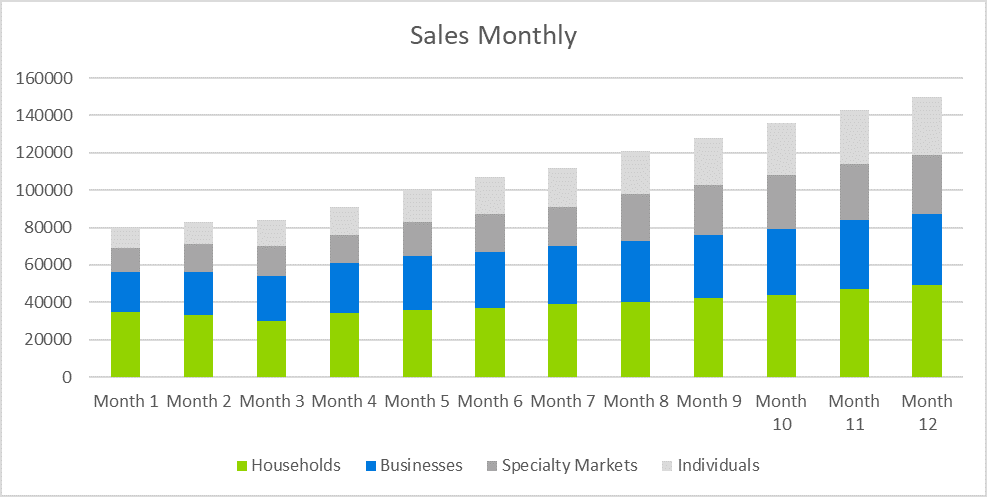
Sales Yearly
Our goal is to generate $120,000 in yearly sales. To achieve this goal, we must attract a minimum of 1,800 customers to our store each year. We will continue to implement promotional activities to reach our target audience and focus on customer retention strategies to ensure that our customers continue to shop with us.
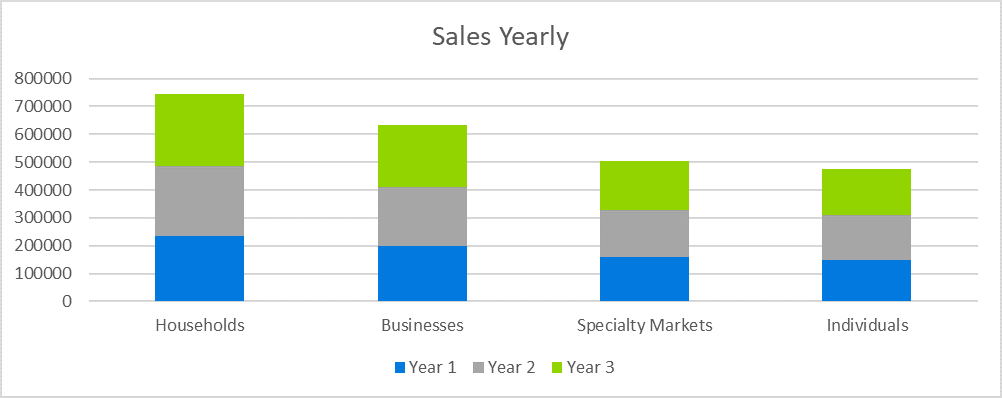
Sales Forecast
In the next five years, we anticipate an increase of 10% in sales per year. We will use traditional and digital marketing tactics to reach our target customers. We will also offer discounts and promotions to encourage customers to purchase from our store.
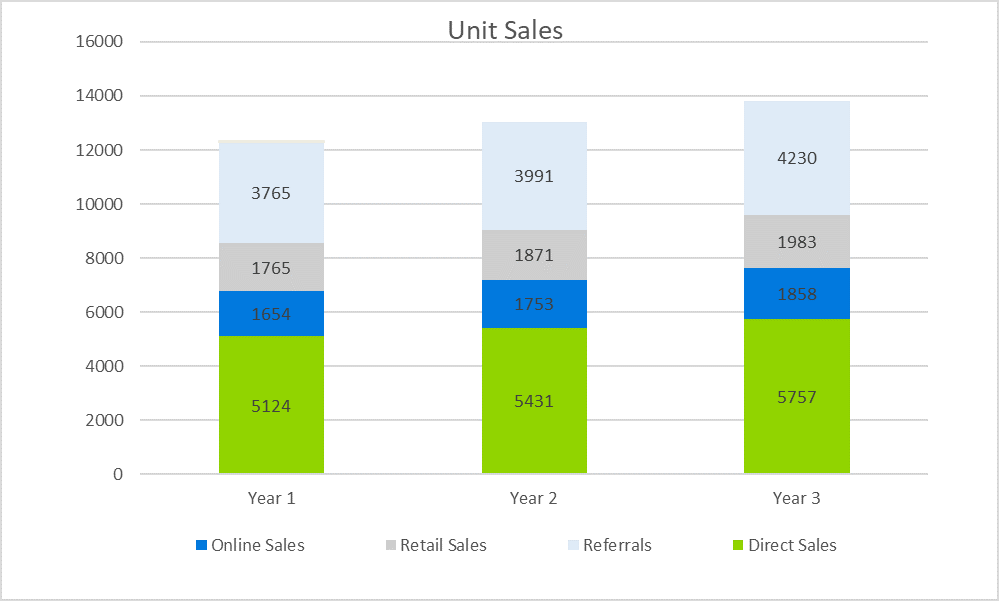
| Sales Forecast | |||
| Unit Sales | Year 1 | Year 2 | Year 3 |
| Direct Sales | 5,124 | 5,431 | 5,757 |
| Online Sales | 1,654 | 1,753 | 1,858 |
| Retail Sales | 1,765 | 1,871 | 1,983 |
| Referrals | 3,765 | 3,991 | 4,230 |
| TOTAL UNIT SALES | 12,308 | 13,046 | 13,829 |
| Unit Prices | Year 1 | Year 2 | Year 3 |
| Direct Sales | $985.00 | $1,142.60 | $1,325.42 |
| Online Sales | $1,540.00 | $1,786.40 | $2,072.22 |
| Retail Sales | $2,000.00 | $2,320.00 | $2,691.20 |
| Referrals | $800.00 | $928.00 | $1,076.48 |
| Sales | |||
| Direct Sales | $5,047,140.00 | $6,205,963.34 | $7,630,852.53 |
| Online Sales | $2,547,160.00 | $3,131,987.94 | $3,851,092.37 |
| Retail Sales | $3,530,000.00 | $4,340,488.00 | $5,337,064.04 |
| Referrals | $3,012,000.00 | $3,703,555.20 | $4,553,891.47 |
| TOTAL SALES | $14,136,300.00 | $17,381,994.48 | $21,372,900.41 |
| Direct Unit Costs | Year 1 | Year 2 | Year 3 |
| Direct Sales | $974.00 | $1,071.40 | $1,124.97 |
| Online Sales | $1,490.00 | $1,639.00 | $1,720.95 |
| Retail Sales | $1,990.00 | $2,189.00 | $2,298.45 |
| Referrals | $795.00 | $874.50 | $918.23 |
| Direct Cost of Sales | |||
| Direct Sales | $4,990,776.00 | $5,819,244.82 | $6,476,819.48 |
| Online Sales | $2,464,460.00 | $2,873,560.36 | $3,198,272.68 |
| Retail Sales | $3,512,350.00 | $4,095,400.10 | $4,558,180.31 |
| Referrals | $2,993,175.00 | $3,490,042.05 | $3,884,416.80 |
| Subtotal Direct Cost of Sales | $13,960,761.00 | $16,278,247.33 | $18,117,689.27 |
7. Personnel Plan
Company Staff
The personnel plan for the grocery store business will depend on the size of the store and the services offered. In how to find a location for the grocery store, Sany got help from brokers for the best location. The following positions are a general list of the positions necessary to run a successful grocery store business:
- CEO and Founder
- Store Manager
- Assistant Store Manager
- Shift Supervisors
- Cashiers
- Stockers
- Cleaners
- Security
Average Salary of Employees
The average salary of employees will depend on the services the store offers and the size of the store. Generally, cashiers and stockers usually earn an annual salary of between $20,000 and $30,000. Managers and assistant managers typically earn an annual salary of between $40,000 and $60,000. Salaries for deli workers, production workers, and other store personnel can vary depending on their experience and the services they provide.
| Personnel Plan | |||
| Year 1 | Year 2 | Year 3 | |
| CEO and Founder | $62,000 | $68,200 | $75,020 |
| Store Manager | $50,000 | $55,000 | $60,500 |
| Assistant Store Manager | $30,000 | $33,000 | $36,300 |
| Shift Supervisors | $44,000 | $48,400 | $53,240 |
| Cashiers | $40,000 | $44,000 | $48,400 |
| Stockers | $30,000 | $33,000 | $36,300 |
| Cleaners | $25,000 | $27,500 | $30,250 |
| Total Salaries | $281,000 | $309,100 | $340,010 |
8. Financial Business Plan for Grocery Store
The financial plan of this grocery store business plan is based on the start-up costs of $50,000. This includes the cost of rent, inventory, equipment, licenses, permits, and other miscellaneous costs. This start-up cost will be financed through a combination of personal funds, a bank loan, and an investor.
Important Assumptions
Grocery store business plan’s financial assumptions:
| General Assumptions | |||
| Year 1 | Year 2 | Year 3 | |
| Plan Month | 1 | 2 | 3 |
| Current Interest Rate | 9.68% | 9.68% | 9.68% |
| Long-term Interest Rate | 9.90% | 9.95% | 9.95% |
| Tax Rate | 26.51% | 26.51% | 26.51% |
| Other | 0 | 0 | 0 |
Changes in regulations or industries can have an impact on financial strategies.
Brake-even Analysis
The brake-even analysis for this grocery store business plan is based on the start-up costs of $50,000. This means that the store must generate $50,000 in sales to break even. This figure is based on the fixed costs of the store, such as rent, payroll, utilities, and other fixed costs.
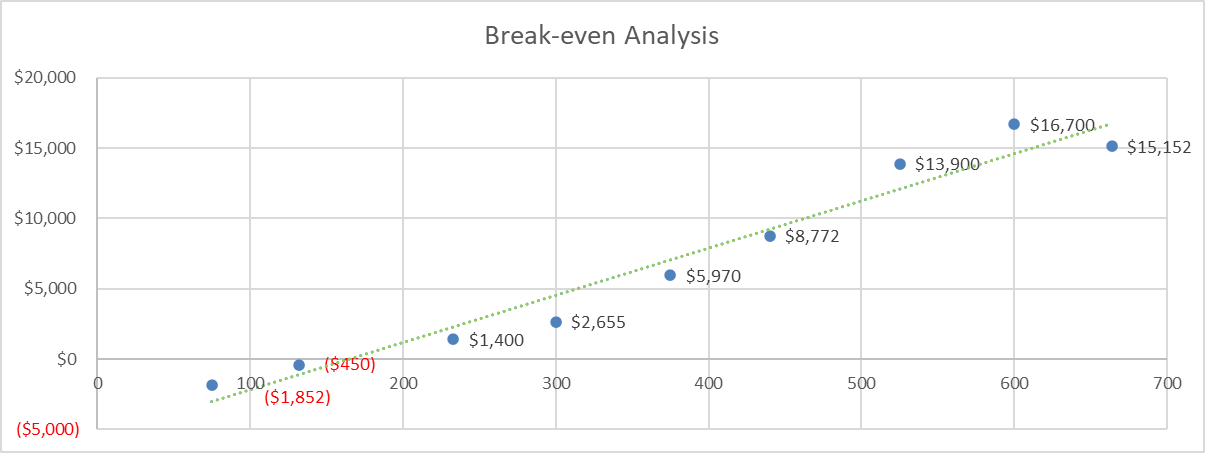
Monthly break-even analysis
| Break-Even Analysis | |
| Monthly Units Break-even | 5092 |
| Monthly Revenue Break-even | $177,540 |
| Assumptions: | |
| Average Per-Unit Revenue | $391.00 |
| Average Per-Unit Variable Cost | $0.68 |
| Estimated Monthly Fixed Cost | $174,192 |
Projected Profit and Loss
The projected profit and loss statement estimate the expected revenue, expenses and profits over a certain period of time. This information can be used to make decisions about the store’s operations and investments.
| Pro Forma Profit And Loss | |||
| Year 1 | Year 2 | Year 3 | |
| Sales | $14,136,300 | $17,381,994 | $21,372,900 |
| Direct Cost of Sales | $13,960,761 | $16,278,247 | $18,117,689 |
| Other | $0 | $0 | $0 |
| TOTAL COST OF SALES | $13,960,761 | $16,278,247 | $18,117,689 |
| Gross Margin | $175,539 | $1,103,747 | $3,255,211 |
| Gross Margin % | 1.24% | 6.35% | 15.23% |
| Expenses | |||
| Payroll | $281,000 | $309,100 | $340,010 |
| Sales and Marketing and Other Expenses | $133,000 | $136,000 | $138,000 |
| Depreciation | $2,100 | $2,200 | $2,400 |
| Leased Equipment | $0 | $0 | $0 |
| Utilities | $2,850 | $2,900 | $3,000 |
| Insurance | $2,150 | $2,100 | $2,100 |
| Rent | $3,500 | $3,500 | $3,600 |
| Payroll Taxes | $22,000 | $23,000 | $24,000 |
| Other | $0 | $0 | $0 |
| Total Operating Expenses | $446,600 | $478,800 | $513,110 |
| Profit Before Interest and Taxes | ($271,061) | $624,947 | $2,742,101 |
| EBITDA | ($271,061) | $624,947 | $2,742,101 |
| Interest Expense | $0 | $0 | $0 |
| Taxes Incurred | ($54,212) | $124,989 | $548,420 |
| Net Profit | ($216,849) | $499,958 | $2,193,681 |
| Net Profit/Sales | -1.53% | 2.88% | 10.26% |
Profit Monthly
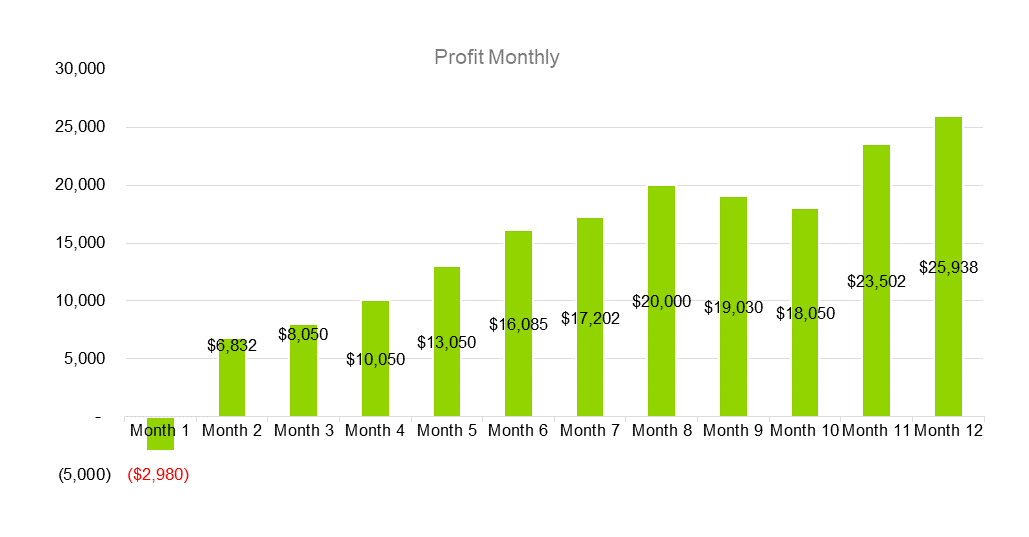
Profit Yearly
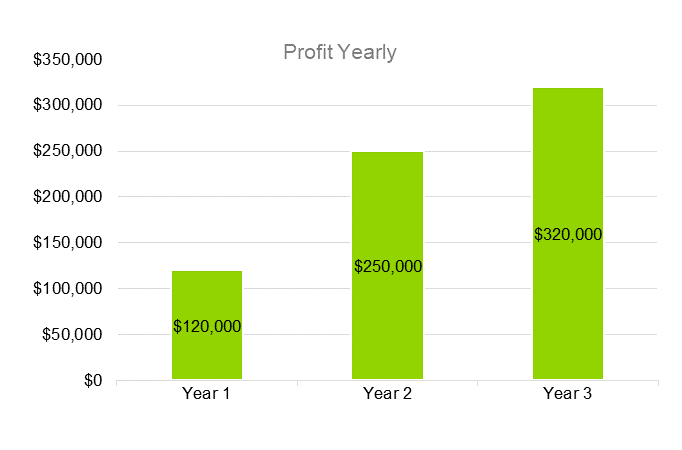
Gross Margin Monthly
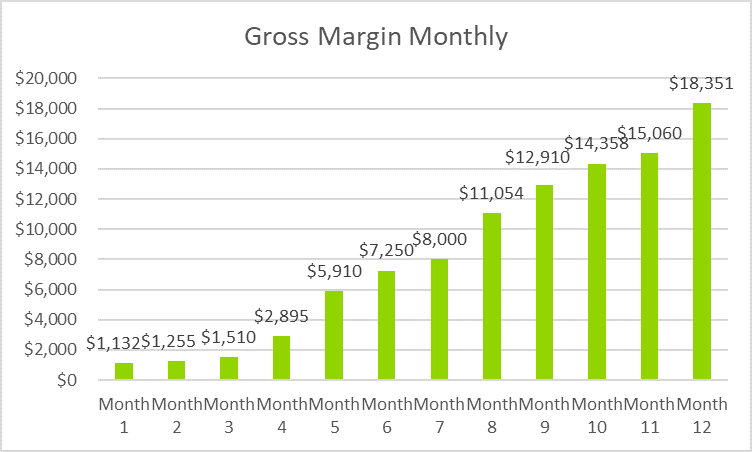
Gross Margin Yearly
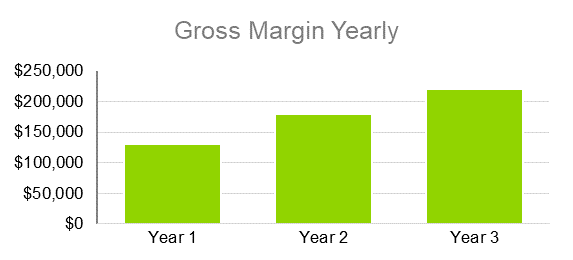
Projected Cash Flow
The retail grocery store business plan also includes a cash flow statement, which will provide a snapshot of the store’s financial health at any given time. The following column diagram illustrates the projected cash flow statement and the sources and uses of cash associated with the grocery store business.
| Pro Forma Cash Flow | |||
| Cash Received | Year 1 | Year 2 | Year 3 |
| Cash from Operations | |||
| Cash Sales | $56,620 | $61,150 | $66,042 |
| Cash from Receivables | $27,662 | $29,875 | $32,265 |
| SUBTOTAL CASH FROM OPERATIONS | $84,282 | $91,867 | $99,217 |
| Additional Cash Received | |||
| Sales Tax, VAT, HST/GST Received | $0 | $0 | $0 |
| New Current Borrowing | $0 | $0 | $0 |
| New Other Liabilities (interest-free) | $0 | $0 | $0 |
| New Long-term Liabilities | $0 | $0 | $0 |
| Sales of Other Current Assets | $0 | $0 | $0 |
| Sales of Long-term Assets | $0 | $0 | $0 |
| New Investment Received | $0 | $0 | $0 |
| SUBTOTAL CASH RECEIVED | $86,000 | $87,050 | $93,050 |
| Expenditures | Year 1 | Year 2 | Year 3 |
| Expenditures from Operations | |||
| Cash Spending | $37,000 | $38,000 | $40,000 |
| Bill Payments | $29,620 | $27,050 | $28,050 |
| SUBTOTAL SPENT ON OPERATIONS | $66,620 | $65,050 | $68,050 |
| Additional Cash Spent | |||
| Sales Tax, VAT, HST/GST Paid Out | $0 | $0 | $0 |
| Principal Repayment of Current Borrowing | $0 | $0 | $0 |
| Other Liabilities Principal Repayment | $0 | $0 | $0 |
| Long-term Liabilities Principal Repayment | $0 | $0 | $0 |
| Purchase Other Current Assets | $0 | $0 | $0 |
| Purchase Long-term Assets | $0 | $0 | $0 |
| Dividends | $0 | $0 | $0 |
| SUBTOTAL CASH SPENT | $62,000 | $66,960 | $72,317 |
| Net Cash Flow | $21,080 | $24,000 | $25,000 |
| Cash Balance | $27,000 | $30,000 | $32,000 |
Projected Balance Sheet
The projected balance sheet will provide an overview of the store’s assets, liabilities, and equity. This statement will help to determine the store’s financial health and inform any potential investors. To create the statement, the store will need to calculate the value of its assets, such as inventory, equipment, and supplies. Additionally, the store will need to estimate the value of its liabilities, such as bank loans and debts.
| Pro Forma Balance Sheet | |||
| Assets | Year 1 | Year 2 | Year 3 |
| Current Assets | |||
| Cash | $301,921 | $338,152 | $371,967 |
| Accounts Receivable | $26,677 | $29,878 | $33,583 |
| Inventory | $7,235 | $8,103 | $4,900 |
| Other Current Assets | $2,315 | $2,707 | $2,707 |
| TOTAL CURRENT ASSETS | $338,148 | $378,840 | $413,157 |
| Long-term Assets | |||
| Long-term Assets | $9,755 | $9,755 | $9,755 |
| Accumulated Depreciation | $17,252 | $19,322 | $21,738 |
| TOTAL LONG-TERM ASSETS | $28,600 | $32,032 | $36,036 |
| TOTAL ASSETS | $366,748 | $410,872 | $449,193 |
| Liabilities and Capital | Year 4 | Year 5 | Year 6 |
| Current Liabilities | |||
| Accounts Payable | $19,800 | $22,176 | $24,926 |
| Current Borrowing | $0 | $0 | $0 |
| Other Current Liabilities | $0 | $0 | $0 |
| SUBTOTAL CURRENT LIABILITIES | $18,300 | $20,496 | $23,038 |
| Long-term Liabilities | $0 | $0 | $0 |
| TOTAL LIABILITIES | $20,100 | $22,512 | $25,303 |
| Paid-in Capital | $50,327 | $63,624 | $65,116 |
| Retained Earnings | $66,121 | $72,072 | $79,279 |
| Earnings | $172,000 | $187,480 | $206,228 |
| TOTAL CAPITAL | $346,648 | $388,360 | $423,890 |
| TOTAL LIABILITIES AND CAPITAL | $366,748 | $410,872 | $449,193 |
| Net Worth | $261,560 | $285,100 | $313,610 |
Business Ratios
The business ratios are another essential part of a grocery store business plan. These ratios measure the performance of the business and provide valuable insight into the business’s overall health. As shown in the table below, the business ratios include profitability, liquidity, and efficiency measures.
| Ratio Analysis | ||||
| Year 1 | Year 2 | Year 3 | INDUSTRY PROFILE | |
| Sales Growth | 6.24% | 6.91% | 7.66% | 3.00% |
| Percent of Total Assets | ||||
| Accounts Receivable | 8.72% | 9.66% | 10.71% | 9.80% |
| Inventory | 6.00% | 6.65% | 7.37% | 9.90% |
| Other Current Assets | 2.84% | 3.15% | 3.49% | 2.40% |
| Total Current Assets | 136.30% | 151.00% | 152.00% | 158.00% |
| Long-term Assets | 14.09% | 14.68% | 13.64% | 15.00% |
| TOTAL ASSETS | 100.00% | 100.00% | 100.00% | 100.00% |
| Current Liabilities | 4.38% | 4.42% | 4.46% | 4.34% |
| Long-term Liabilities | 0.00% | 0.00% | 0.00% | 0.00% |
| Total Liabilities | 7.02% | 7.08% | 7.14% | 7.38% |
| NET WORTH | 100.03% | 100.83% | 101.76% | 110.00% |
| Percent of Sales | ||||
| Sales | 100.00% | 100.00% | 100.00% | 100.00% |
| Gross Margin | 92.05% | 94.54% | 97.18% | 99.00% |
| Selling, General & Administrative Expenses | 97.80% | 100.44% | 103.25% | 97.80% |
| Advertising Expenses | 1.42% | 1.46% | 1.50% | 1.40% |
| Profit Before Interest and Taxes | 39.90% | 40.98% | 42.12% | 33.90% |
| Main Ratios | ||||
| Current | 33 | 34 | 35 | 33 |
| Quick | 32 | 33.2 | 34.03 | 33 |
| Total Debt to Total Assets | 0.18% | 0.18% | 0.17% | 0.40% |
| Pre-tax Return on Net Worth | 75.38% | 75.58% | 76.38% | 76.38% |
| Pre-tax Return on Assets | 96.88% | 101.72% | 106.81% | 111.30% |
| Additional Ratios | Year 1 | Year 2 | Year 3 | |
| Net Profit Margin | 35.51% | 36.61% | 37.75% | N.A. |
| Return on Equity | 57.20% | 58.97% | 60.80% | N.A. |
| Activity Ratios | ||||
| Accounts Receivable Turnover | 7.7 | 7.7 | 7.8 | N.A. |
| Collection Days | 100 | 100 | 100 | N.A. |
| Inventory Turnover | 23.3 | 24.465 | 32 | N.A. |
| Accounts Payable Turnover | 14.9 | 16 | 16.3 | N.A. |
| Payment Days | 21 | 20 | 20 | N.A. |
| Total Asset Turnover | 2.6 | 2.5 | 2.6 | N.A. |
| Debt Ratios | ||||
| Debt to Net Worth | -0.04 | -0.03 | -0.04 | N.A. |
| Current Liab. to Liab. | 1 | 1 | 1 | N.A. |
| Liquidity Ratios | ||||
| Net Working Capital | $218,000 | $230,208 | $243,100 | N.A. |
| Interest Coverage | 0 | 0 | 0 | N.A. |
| Additional Ratios | ||||
| Assets to Sales | 0.85 | 0.87 | 0.89 | N.A. |
| Current Debt/Total Assets | 1% | 0% | 0% | N.A. |
| Acid Test | 25.06 | 25.13 | 25.77 | N.A. |
| Sales/Net Worth | 2.1 | 2.2 | 2.2 | N.A. |
| Dividend Payout | 0 | 0 | 0 | N.A. |
9. FAQ
- What is the most profitable part of a grocery store?
The most profitable part of a grocery store typically is the center aisles, which are often referred to as the “center store” or “dry grocery”. These aisles contain items like canned goods, snacks, breakfast items, and other non-perishable food items. These items typically have higher profit margins than items located in the perimeter of the store, such as produce and meats. - How hard is it to run a grocery store?
Running a grocery store is a complex and challenging task. It requires a lot of hard work and dedication to ensure that the store is well-run and profitable. You must be familiar with retail operations and understand the needs of customers. You also need to be able to manage staff, keep up with inventory, and stay on top of financials. Additionally, you must be able to develop relationships with suppliers, create effective marketing strategies, and stay up-to-date with industry trends.
Download Grocery Store Business Plan in PDF
OGSCapital’s team has assisted thousands of entrepreneurs with top-rate business plan development, consultancy and analysis. They’ve helped thousands of SME owners secure more than $1.5 billion in funding, and they can do the same for you.



